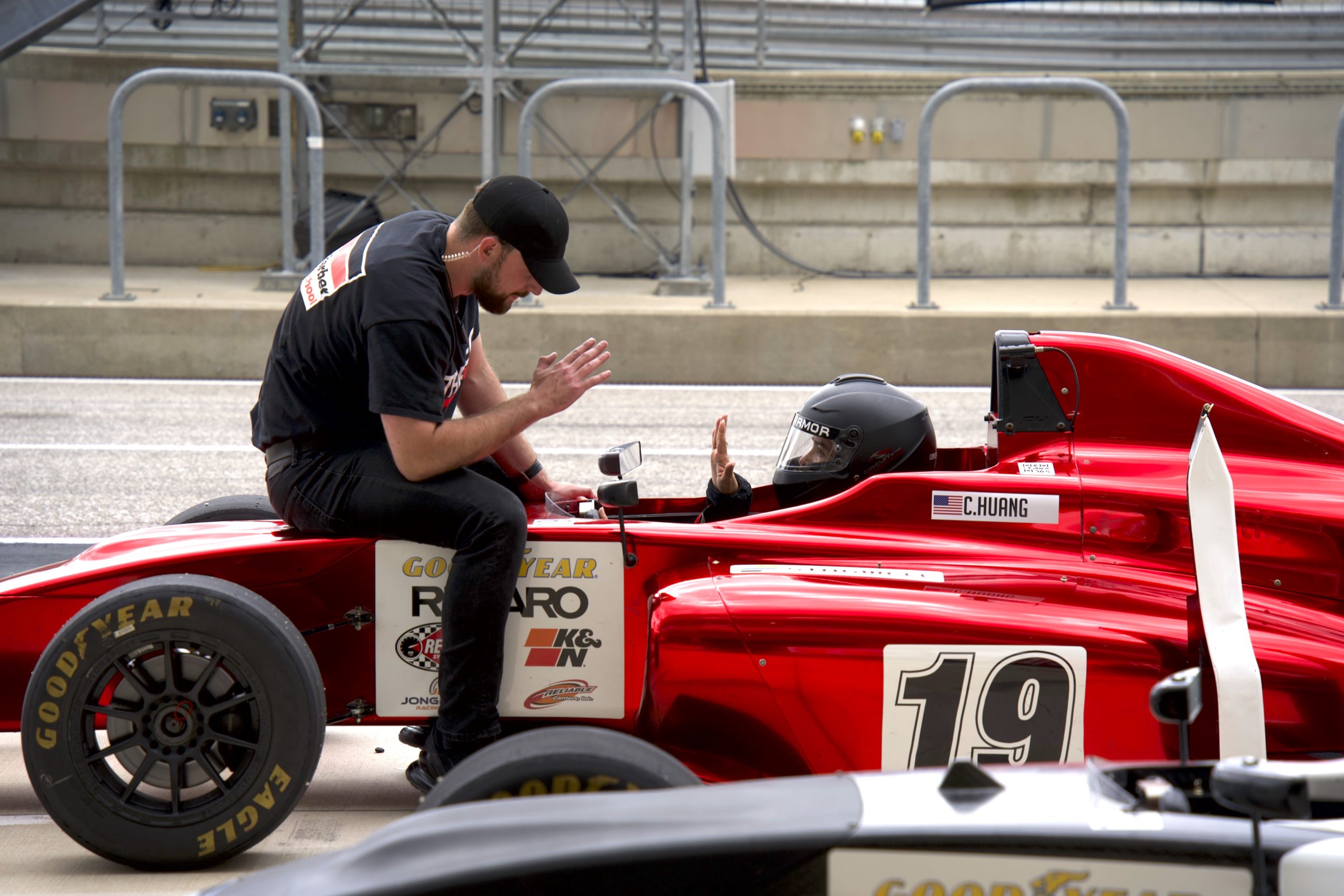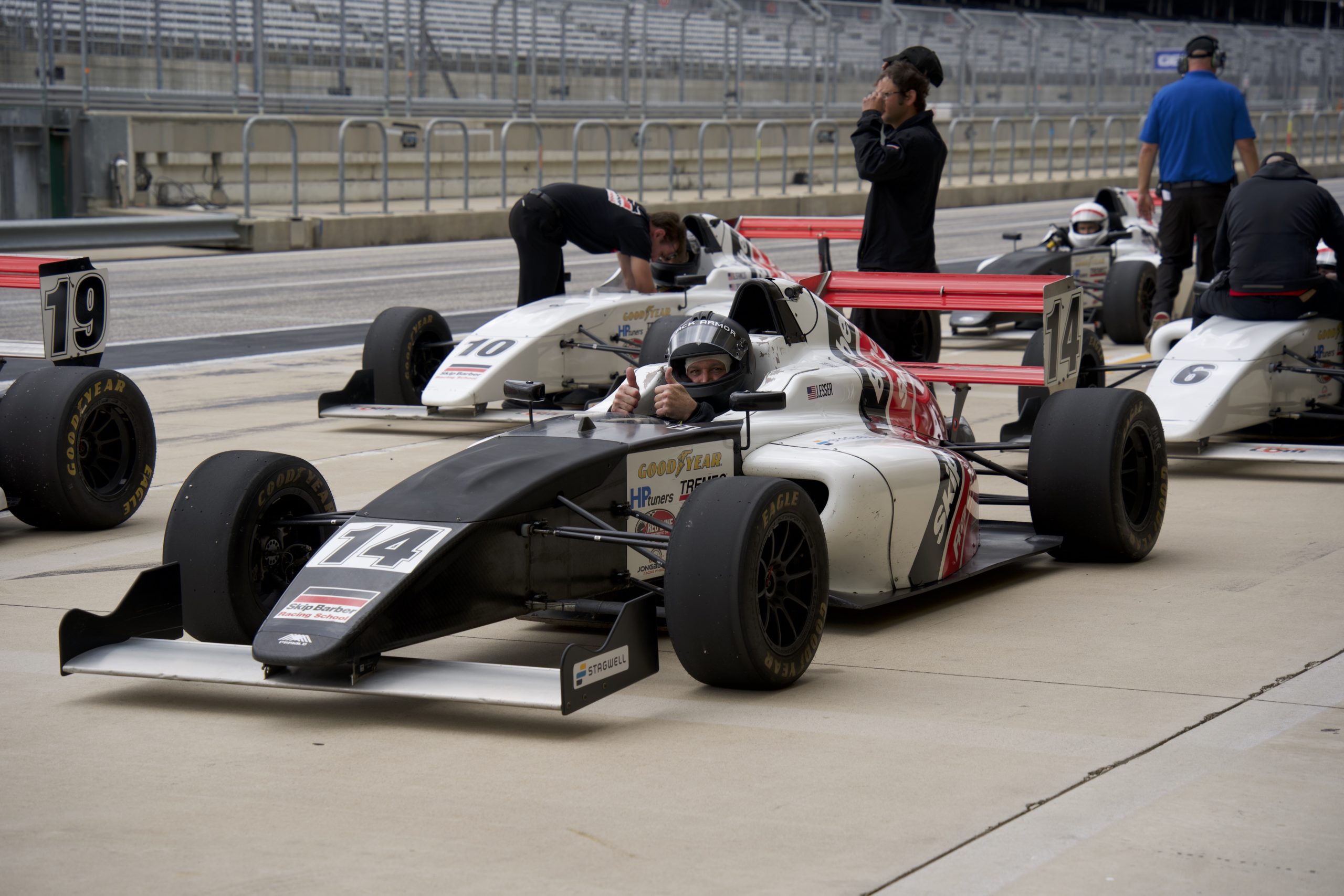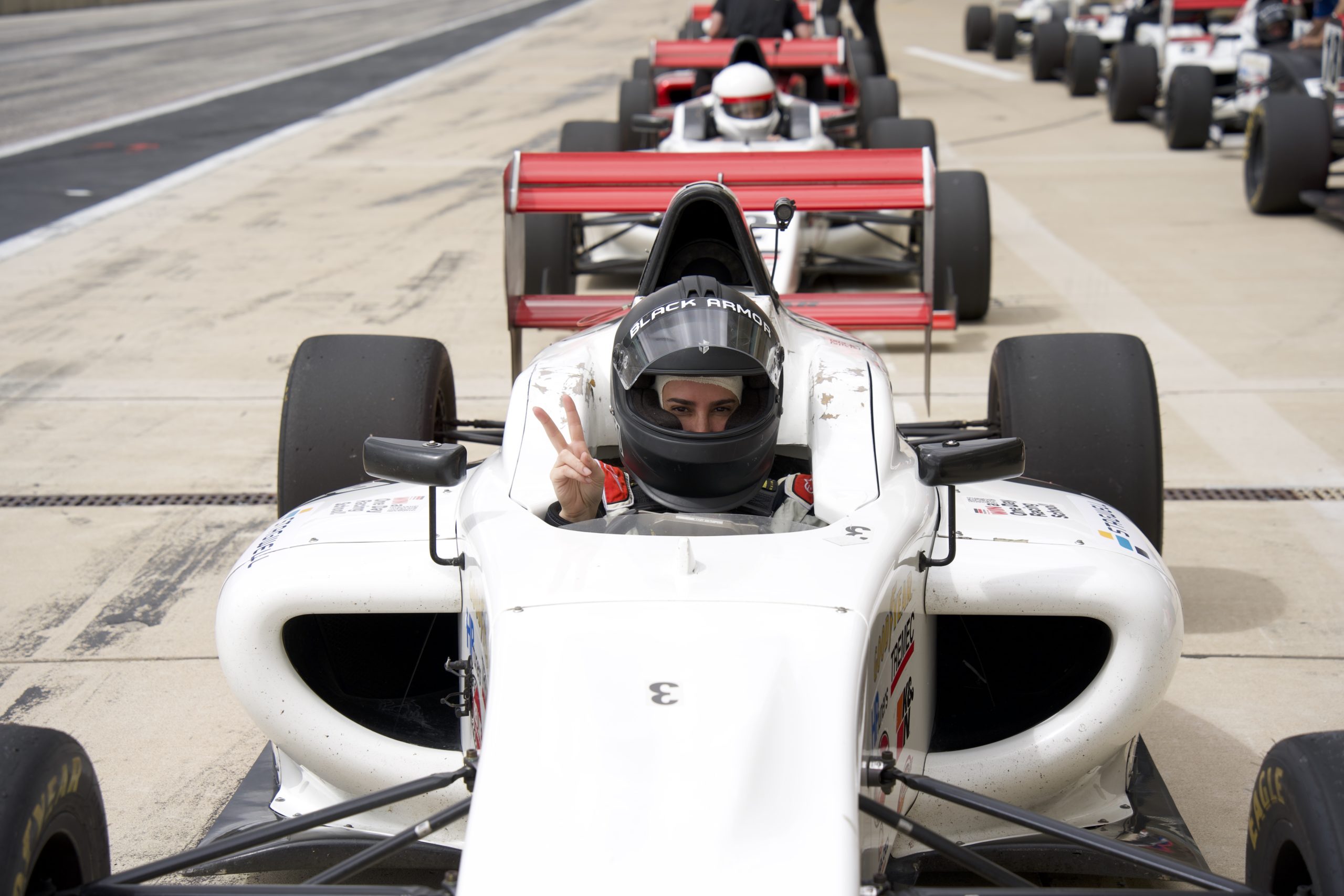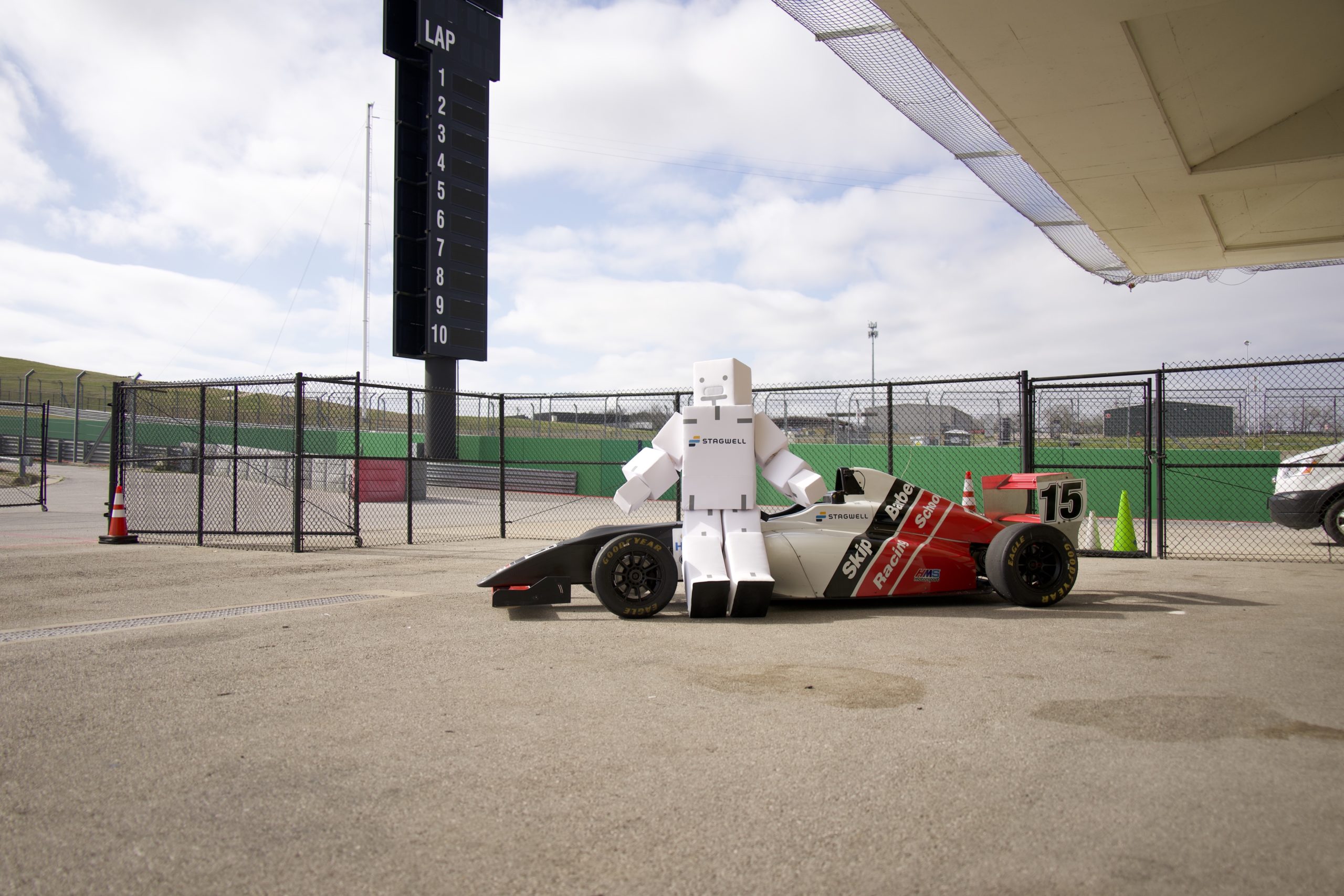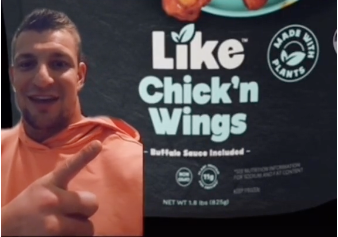New Partnership Gives Harris Poll Clients Access to PRophet’s AI-Driven PR Software to Inform Survey Design and Maximize Press Coverage of Research Results


NEW YORK – June 15, 2022 – PRophet, the first-ever AI-driven PR pitch platform built by and for PR professionals that predicts media interest and sentiment, today announced a partnership with leading global market research and consulting firm, The Harris Poll, that will maximize results for Harris clients and provide access to PRophet’s innovative platform. Both firms sit within Stagwell (NASDAQ: STGW), the challenger network built to transform marketing.
Through this partnership, Harris Poll clients will receive access to the innovative PRophet software platform to test the “mediability” of their research before conducting survey field work, to confirm the data they seek will in fact be of interest to journalists. Upon survey completion, Harris clients can then use PRophet’s machine learning and natural language processing technology to test the news angle of their poll to identify the journalists most likely to cover their story and predict how positively they’d write about the results.
“For nearly two years, PRophet’s focus has remained exclusively on improving the earned media performance of PR professionals. We do this by making teams smarter and more performative, slashing countless hours that brands and agency teams spend on mindless tasks such as media list building and patchwork PR pitch guessing games,” said Aaron Kwittken, founder and CEO, PRophet. “We are thrilled to now bring our predictive technology to support the construction and execution of the critical research completed by those same brands and agencies in conjunction with the highly acclaimed, global research leader, The Harris Poll.”
Clients of The Harris Poll will receive and maintain access to the PRophet platform through completion of the marketing efforts around the poll’s results. Clients will then have the option to extend their access to the platform via PRophet’s monthly pay-as-you-go subscription or through an enterprise subscription available to brands and agencies.
“PRophet is a first-class PR performance platform that will help our clients optimize the design of their thought leadership surveys and improve internal media strategies that lead to even greater performance of their PR campaigns,” said Erica Parker, Managing Director of the Media Communications Research Practice at The Harris Poll. “Journalist interest will always be an essential part of every thought leadership project, as it bridges the critical gap between content owner and visibility among critical stakeholders, including the public. Our partnership with PRophet will lead to even more compelling surveys for our clients while helping them perfect their media outreach.”
PRophet is part of the Stagwell Marketing Cloud, a suite of technology products that support in-house marketing transformation for modern businesses. To learn more about PRophet, please visit www.prprophet.ai or email sales@prprophet.ai to schedule a demo. Learn how Harris’ Media Communications Research Practice can help you own and tell your story in our constantly evolving media landscape at theharrispoll.com/solutions/harris-custom-research. For more information on the Stagwell Marketing Cloud, reach out to hello@stagwellglobal.com.
About PRophet
PRophet is the first-ever A.I.-driven data-as-a-service (DaaS) platform designed by and for the PR community. The platform helps earned media professionals use data to land more media placements by analyzing past stories to predict future media interest and sentiment using natural language processing and machine learning. Founded by PR and marketing industry thought leader and entrepreneur Aaron Kwittken, and launched in 2020, PRophet is part the Stagwell Marketing Cloud. It’s available to agencies, brands and individuals through an enterprise license or a monthly pay-as-you-go plan. To learn more, visit prprophet.ai.
About The Harris Poll
The Harris Poll is one of the longest-running surveys in the U.S., tracking public opinion, motivations, and social sentiment since 1963. The Media Communications Research Practice supports the full scope of clients’ data-driven communications strategy, including paid, earned, social and owned media. Whether the goal is to own and tell their own story through thought leadership research, to measure what the public thinks or knows through public opinion polling, or to influence the policy and legislative agenda by taking a public affairs lens, our consultants guide the research and analysis process, from discovering a unique space a client can own through supporting the full range of outreach activities.
About Stagwell Inc.
Stagwell is the challenger network built to transform marketing. We deliver scaled creative performance for the world’s most ambitious brands, connecting culture-moving creativity with leading-edge technology to harmonize the art and science of marketing. Led by entrepreneurs, our 12,000+ specialists in 34+ countries are unified under a single purpose: to drive effectiveness and improve business results for their clients. Join us at www.stagwellglobal.com.
###
Related
Articles
Events, In the News, Investments & Financials, Press Releases
Jun 09, 2025
Stagwell (STGW) CEO and Chairman Mark Penn to Host Ask Me Anything (AMA) on Reddit to Discuss the Future of Marketing

Events, In the News, Press Releases, Talent & Awards
Jun 05, 2025
Code and Theory Named ANA B2B Agency of the Year After Transforming the World’s Leading Brands

Investments & Financials, Press Releases
May 22, 2025
Stagwell Inc. (STGW) Reports Equity Inducement Grants Under Nasdaq Listing Rule 5635(c)(4)

Newsletter
Sign Up
Originally released on
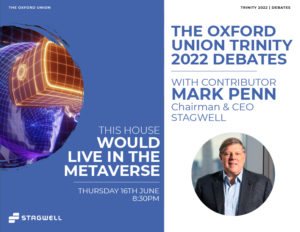
NEW YORK and OXFORD, England – June 7, 2022 – Stagwell (Nasdaq: STGW), the challenger network built to transform marketing, today announced Chairman and CEO Mark Penn will join The Oxford Union, the world’s most prestigious debating society, to debate the promises and pitfalls of the metaverse. The debate, “This House Would Live in the Metaverse,” will explore the future of Web3 and the metaverse in the context of data and privacy, brand marketing, and ultimately, how the metaverse will transform the way people, countries, and communities connect. Stagwell invites press to attend the debate at 8:30 p.m. GMT+1 on Thursday, June 16; details to RSVP are below.
Penn will argue on behalf of the metaverse as a platform that can transform how brands relate – and market – to consumers. Stagwell is excited about the potential of Web3 and currently counsels multinational brands on whether and how to enter the metaverse, including areas of investment to consider within augmented reality (AR), non-fungible tokens (NFTs), the creator economy, and other areas of opportunity.
“We’ve only just scratched the surface of AR, VR, NFTs and other emerging technologies in the metaverse, and I’m excited to join this expert group as we debate the possibilities,” said Stagwell Chairman and CEO Mark Penn. “The metaverse provides an entirely new canvas for brands to build creative, digital experiences that connect consumers around the world.”
Current confirmed debaters include:
Proposition Side
- Stagwell Chairman and CEO Mark Penn
- AGT International Chairman & Owner Mati Kochavi
Opposition Side
- University of Birmingham Professor Sylvie Delacroix
- Bloomberg and Techworld journalist Margi Murphy
- TechCrunch Editor-at-Large Mike Butcher
Journalists interested in attending the debate and/or connecting with Penn for an interview, please contact Beth Sidhu at beth.sidhu@stagwellglobal.com.
About Stagwell Inc.
Stagwell is the challenger network built to transform marketing. We deliver scaled creative performance for the world’s most ambitious brands, connecting culture-moving creativity with leading-edge technology to harmonize the art and science of marketing. Led by entrepreneurs, our 10,000+ specialists in 34+ countries are unified under a single purpose: to drive effectiveness and improve business results for their clients. Join us at www.stagwellglobal.com.
About The Oxford Union
Founded in 1823, the Oxford Union is a forward-thinking institution at Oxford University that strives to strengthen democratic values through free and fair discussion. Having invited illustrious guests from the Dalai Lama to Presidents Carter, Nixon, and Reagan, the Oxford Union allows its members to debate and question the modern thinkers of our time. Diversity, not only of opinion or politics but of all types, remains the lifeblood of the Union today, and continues to be so for as long as we are visited by the greatest and most knowledgeable speakers in the world.
Contact: Beth Sidhu
beth.sidhu@stagwellglobal.com
+1. 202.423.4414
Related
Articles
In the News, Press Releases, Thought Leadership
Jun 10, 2025
Stagwell (STGW) Chairman and CEO Mark Penn to Discuss the Irreplaceable Power of Human Creativity on the Main Stage of Cannes Lions

Events, In the News, Press Releases, Talent & Awards
Jun 05, 2025
Code and Theory Named ANA B2B Agency of the Year After Transforming the World’s Leading Brands

In the News, Press Releases, Talent & Awards
May 19, 2025
Stagwell (STGW) Appoints Connie Chan as Chief Growth Officer for Asia Pacific

Newsletter
Sign Up
Originally released on
First Joint Out-of-Home (OOH) Campaign for Converse Achieves Meaningful Impact
NEW YORK and LONDON – May 23, 2022 – Stagwell Media Network, part of Stagwell (NASDAQ: STGW), today announced the integration of the U.S. OOH teams from the network’s omnichannel media agency, Assembly, with Talon, to offer smarter, data-driven, and creative-led OOH planning, buying, and proprietary technologies to advertisers. This move represents the next phase of the strategic partnership formed at the end of last year. Together, the team has since successfully collaborated with Converse on an innovative OOH program that has driven meaningful results for this influential brand.

Jill Rynenberg, Integrated Digital Marketing Manager, Converse commented, “Out-of-home was integral to Converse’s ‘Create Next’ campaign which saw John Boyega, an influential film star, born and raised in South London, join forces with Converse. It was really important to target the hometowns of Boyega and the five young and undiscovered London filmmakers which we were able to deliver through Talon’s bespoke solutions. This was our first out-of-home campaign planned through Assembly and Talon Outdoor, and we were delighted with Talon’s collaborative and data-led approach to planning.”
Rynenberg continued, “Using Talon’s proprietary data management platform, ‘Ada,’ billions of device-level audience data points were activated in order to pinpoint a highly targeted bespoke urban audience in these key hometown locations centred around Peckham and Brixton. Talon worked collaboratively with Assembly and Converse to deliver this highly targeted campaign which was delivered at breakneck speed. Talon’s audience-first data intelligence approach to planning allowed us to reach more of the right audience at the right time, ultimately improving ROI on media spend. We look forward to extending this partnership to deliver many more OOH campaigns.”
“While OOH revenues were impacted by the pandemic, channel innovations, real-time flexibility, and accelerated creativity has repositioned OOH in the mind of consumers and brands, as demonstrated by the Converse campaign,” said Jon Schaaf, Global Chief Investment Officer, Stagwell Media Network. “By further combining our experience, teams, tools, and industry partnerships, our collaboration with Talon will enable marketers to differentiate their brand and offerings from their competition across both upper and lower funnel efforts.”
Barry Cupples, Talon’s Global CEO said, “Stagwell’s technology-first approach coupled with their deep expertise in media, creative and digital transformation dovetails seamlessly alongside Talon’s. OOH is more powerful than ever; harnessing data-fuelled technology with capabilities for audience targeting and measurement across the customer journey is bringing game-changing opportunities for advertisers.” Cupples continued, “The strengthening of our partnership with combined goals to drive effectiveness and improve business results for clients will undoubtedly deliver better outcomes for brands and add genuine value to the top and bottom line.”
About Stagwell:
Stagwell is the challenger network built to transform marketing. We deliver scaled creative performance for the world’s most ambitious brands, connecting culture-moving creativity with leading-edge technology to harmonize the art and science of marketing. Led by entrepreneurs, our 10,000+ specialists in 34+ countries are unified under a single purpose: to drive effectiveness and improve business results for their clients. Join us at www.stagwellglobal.com.
About Stagwell Media Network:
Stagwell’s Media Network is a group of leading multichannel agencies home to more than 3,500 experts with an expansive global footprint across 40+ offices in 20 countries, managing close to $5 billion in media. Agencies include omnichannel agencies Assembly, Brand New Galaxy, MMI, Goodstuff and Grason, creative consultancy GALE, B2B specialist Multiview, multi-lingual content agency Locaria, and travel and media experts Ink. The network offers marketers a more dynamic partner for global B2B and B2C solutions spanning data, technology, media, and creativity aimed at accelerating business growth for brands worldwide.
About Talon:
Talon Outdoor is the leading global independent Out of Home (OOH) media specialist and technology services company focused on delivering smarter, creative, data-driven integrated OOH communications. Combining independence with a collaborative approach, Talon promotes open and transparent working relationships between many of the world’s leading agencies, clients, and media partners. Headquartered in London with offices in Dubai, Dublin, Frankfurt, Manchester, New York, and Singapore Talon delivers expertise at the global, national, regional, and local levels. Additionally, the agency has built a global OOH planning and buying network covering 100 markets across the U.S., Europe, Asia, and Latin America. For more information, please visit www.talonoutdoor.com and follow up on Twitter and LinkedIn.
About Assembly:
Assembly is made of the ingredients of the modern agency, bringing together data, talent, and technology to deliver a connected set of solutions for media + more to the best brands on the planet. We’re home to more than 1,500 of the industry’s top talent, who bring unmatched global omnichannel media expertise + data, technology, and business consulting capabilities that help brands find the change that fuels growth. Assembly is a proud member of Stagwell, the challenger network built to transform marketing. Visit www.assemblyglobal.com for more information.
Media Contacts:
Talon UK: Kate Chaundy – Propeller kate.chaundy@propellergroup.com
Talon America: Ray Yeung + Nancy Zakhary | Relev8 | ray@relev8.co + nancy@relev8.co
Stagwell: Beth Sidhu beth.sidhu@stagwellglobal.com| +1. 202.423.4414
# # #

Related
Articles
In the News, Press Releases, Thought Leadership
Jun 10, 2025
Stagwell (STGW) Chairman and CEO Mark Penn to Discuss the Irreplaceable Power of Human Creativity on the Main Stage of Cannes Lions

Events, In the News, Press Releases, Talent & Awards
Jun 05, 2025
Code and Theory Named ANA B2B Agency of the Year After Transforming the World’s Leading Brands

In the News, Press Releases, Talent & Awards
May 19, 2025
Stagwell (STGW) Appoints Connie Chan as Chief Growth Officer for Asia Pacific

Newsletter
Sign Up
Originally released on
NEW YORK, May 24, 2022 /PRNewswire/ — Grocery stores are riding reputational highs two years after the start of COVID-19 – with regional chains in particular being recognized for weathering the supply-chain storm. At the same time, the pandemic-era halo many industries enjoyed are beginning to normalize.
Those are among the insights of the Axios-Harris Poll 100, an annual ranking of the reputations of the most visible U.S. companies, which was released today.
Trader Joe’s, HEB Grocery, Patagonia, Hershey and Wegmans have the top-five best reputations in America on the 2022 Axios-Harris Poll 100 list.
Social media platforms and companies with missteps on social issues are the ones with the poorest reputations or that suffered the steepest declines. This year, The Trump Organization, Wish.com, Twitter, Facebook and Fox Corporation are at the bottom of the 23rd annual list, with poor reputations.
“As Americans move on from COVID, they are looking at corporate reputation through a more practical lens,” said John Gerzema, CEO of The Harris Poll. “Companies delivering on time and keeping their promises despite supply-chain issues are being held in high regard. Businesses that also do their part to create a better world – whether through sustainability or taking a stand on authentic social issues – also are being rewarded.”
The Axios-Harris Poll 100 has ranked reputation since 1999. The survey’s Reputation Quotient (RQ) ranking is based on companies that are most visible to the general population and on their performance in seven key areas:
- Trust – “Is this a company I trust?”
- Vision – “Does this company have a clear vision for the future?”
- Growth – “Is this a growing company?”
- Products and Services – “Does this company develop innovative products and services that I want and value?”
- Culture – “Is this a good company to work for?”
- Ethics – “Does this company maintain high ethical standards?”
- Citizenship – “Does this company share my values and support good causes?”
“It’s back to basics with companies that offer quality products and are guided by steadfast values riding to the top,” said Stagwell Chairman and CEO Mark Penn. “Those that became enmeshed in political quagmires tended to be set back.”
This year, grocery dominates the top 100 list. Three grocers (Trader Joe’s, HEB Grocery and Wegmans) are in the top five. Two other grocery chains (Publix and Kroger) are among the top 25.
“The poll reinforces what we have seen on the ground with our local news product Axios Local,” said Jim VandeHei, co-founder and CEO of Axios. “To reestablish trust with a skeptical population, you have to start closer to home, making a real impact within local communities. Consumers reward brands that deliver a trusted product on time and as promised.”
Among the insights from this year’s study:
- Most visible: Amazon and Walmart are once again the two most visible companies in America, followed by Apple, Facebook, Google, Target, Nike, Microsoft, McDonald’s and AT&T.
- New to the list: Newly added to the 100 most visible companies list for the first time ever are Trader Joe’s, Spotify, Big Lots, Shein and Subway.
- Top 10: The most visible and most reputable companies – Trader Joe’s, HEB Grocery, Patagonia, Hershey, Wegmans, Samsung, Toyota, Amazon and Honda – are separated by only small degrees. All but Patagonia and Honda improved their reputations from last year’s highs.
- Industry movement: As the world moves out of the crisis phase of the pandemic, industries that saw massive reputations boosted by the crisis have returned to pre-pandemic levels. Consumer products dropped 12 points from 2021, returning to 2019 levels (2022: 62% positive, 2021: 74%, 2019: 61%). Meanwhile, while the halo surrounding the pharmaceutical and health insurance industries is fading, both remain significantly above pre-pandemic levels (pharma 2022: 49% positive, 2021: 60%, 2019: 31%) and (health insurance 2022: 49% positive, 2021: 60%, 2019: 32%).
- Perils of speaking out, or not: The economic and reputational loss from polarization hit companies once immune to politics and controversy. Disney fell significantly from last year – with the impact of being caught in a fight between politics and company values. Patagonia – which was number one on the list last year – continues its reputational high with great products combined with a strong societal view.
- Biggest improvements: Companies with at least a good reputation and the strong year-over-year improvement include AT&T (up 6.3%), Google (6.1%), Starbucks (6.0%), Yum! Brands (5.4%), General Motors (4.7%) and The Home Depot (4.5%)
- Biggest declines: Companies with the biggest reputational declines from last year include Stellantis (down 8.0%), Twitter (-4.9%), Pfizer (-4.7%), Disney (-4.3%), Trump Organization (-4.3%), Chick-fil-A (-3.7%), PepsiCo (-3.5%), eBay (-3.3%), ExxonMobil (-3.3%) and Electronic Arts (-3.2%).
“To excel at reputation, companies must deliver high marks on business performance, corporate character and trust,” said Ray Day, vice chair of Stagwell, which includes The Harris Poll. “While you can build a brand, you earn a reputation. Companies with strong reputations have a price advantage, a competitive advantage and a talent advantage. That’s why reputation needs to be a priority from the board room to the C-suite.”
The Axios Harris Poll 100 is based on a survey of 33,096 Americans in a nationally representative sample conducted March 11-April 3, 2022. The two-step process starts fresh each year by surveying the public’s top-of-mind awareness of companies that either excel or falter. These 100 “most visible companies” are then ranked by a second group of Americans across the seven key dimensions of reputation to arrive at the ranking. If a company is not on the list, it did not reach a critical level of visibility to be measured.
For information on all companies and their ranking on the 2022 Axios-Harris Poll 100, click here and here for an interactive graphic.
About The Harris Poll
The Harris Poll is one of the longest-running surveys in the U.S., tracking public opinion, motivations and social sentiment since 1963. It is now part of Harris Insights & Analytics, a global consulting and market research firm that delivers social intelligence for transformational times. We work with clients in three primary areas: building 21st century corporate reputation, crafting brand strategy and performance tracking, and earning organic media through public relations research. Our mission is to provide insights and advisory to help leaders make the best decisions possible. Learn more by visiting www.harrispoll.com and follow Harris Poll on Twitter and LinkedIn.
About Axios
Axios is a digital media company launched in 2017. Axios – which means “worthy” in Greek – helps you become smarter, faster with news and information across politics, tech, business, media, science and the world. Subscribe to our newsletters at axios.com/newsletters and download our mobile app at axios.com/app.
About Stagwell
Stagwell is the challenger network built to transform marketing. We deliver scaled creative performance for the world’s most ambitious brands, connecting culture-moving creativity with leading-edge technology to harmonize the art and science of marketing. Led by entrepreneurs, our 10,000+ specialists in 34+ countries are unified under a single purpose: to drive effectiveness and improve business results for their clients. Join us at www.stagwellglobal.com.
Related
Articles
In the News, Press Releases, Thought Leadership
Jun 10, 2025
Stagwell (STGW) Chairman and CEO Mark Penn to Discuss the Irreplaceable Power of Human Creativity on the Main Stage of Cannes Lions

Events, In the News, Press Releases, Talent & Awards
Jun 05, 2025
Code and Theory Named ANA B2B Agency of the Year After Transforming the World’s Leading Brands

In the News, Press Releases, Talent & Awards
May 19, 2025
Stagwell (STGW) Appoints Connie Chan as Chief Growth Officer for Asia Pacific

Newsletter
Sign Up
Originally released on
Chariman and CEO Mark Penn to Participate in a Fireside Chat
NEW YORK and BOSTON, May 13, 2022 /PRNewswire/ — Stagwell (NASDAQ: STGW) announced today that Chairman and CEO Mark Penn will attend the upcoming J.P. Morgan 50th Annual Global Technology, Media and Communications Conference, taking place May 23-25 in Boston. Penn will participate in a fireside chat with Q&A to follow. The session will take place at 3:50 p.m. EDT on Monday, May 23. To register and access the presentation, please visit this link.
Penn will also be available for 1:1 investor meetings. For more information, please reach out to ir@stagwellglobal.com.
Stagwell reported Q1 2022 earnings on Friday, May 6, and released its 2021 Annual Report on Monday, May 2.
About Stagwell Inc.
Stagwell is the challenger network built to transform marketing. We deliver scaled creative performance for the world’s most ambitious brands, connecting culture-moving creativity with leading-edge technology to harmonize the art and science of marketing. Led by entrepreneurs, our 10,000+ specialists in 34+ countries are unified under a single purpose: to drive effectiveness and improve business results for their clients. Join us at www.stagwellglobal.com.
Contact: Michaela Pewarski
Related
Articles
In the News, Press Releases
Jun 13, 2025
Stagwell (STGW) Unveils Official News Network as an Extension of its Future of News Initiative, Allowing Clients Direct Access to Leading News Publishers
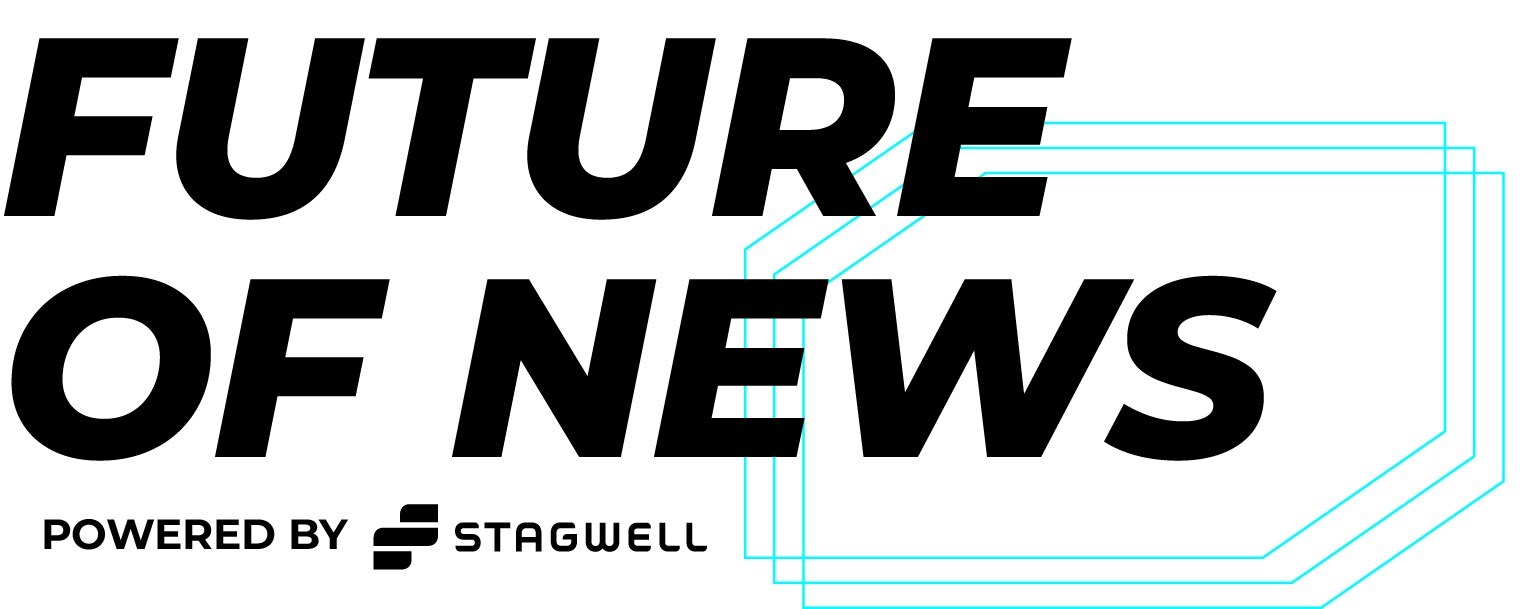
Artificial Intelligence, In the News, Marketing Frontiers, Press Releases, Stagwell Marketing Cloud, Tech
Jun 12, 2025
PRophet, a Stagwell (STGW) Company, Completes Integration of UNICEPTA, Launches Unified Brand and Enhanced Media Intelligence Offering

In the News, Marketing Frontiers, Press Releases, Stagwell Marketing Cloud, Tech
Jun 11, 2025
The Marketing Cloud Launches Cutting-Edge Platform to Simplify Marketing Workflows

Newsletter
Sign Up
Originally released on
NEW YORK, May 9, 2022 /PRNewswire/ — Stagwell (NASDAQ: STGW) announced today that Chairman and CEO Mark Penn will attend the upcoming Needham Technology & Media Conference on Monday, May 16, and Tuesday, May 17. Penn will deliver a virtual presentation at 12:45 EDT on Monday, May 16. To register and access the presentation, please visit this link.
Penn will also be available for 1:1 investor meetings virtually on May 16 and in person on May 17. For more information, please reach out to ir@stagwellglobal.com.
Stagwell reported Q1 2022 earnings on Friday, May 6, and released its 2021 Annual Report on Monday, May 2.
About Stagwell Inc.
Stagwell is the challenger network built to transform marketing. We deliver scaled creative performance for the world’s most ambitious brands, connecting culture-moving creativity with leading-edge technology to harmonize the art and science of marketing. Led by entrepreneurs, our 10,000+ specialists in 34+ countries are unified under a single purpose: to drive effectiveness and improve business results for their clients. Join us at www.stagwellglobal.com.
Contact: Michaela Pewarski
Related
Articles
In the News, Press Releases
Jun 13, 2025
Stagwell (STGW) Unveils Official News Network as an Extension of its Future of News Initiative, Allowing Clients Direct Access to Leading News Publishers

Artificial Intelligence, In the News, Marketing Frontiers, Press Releases, Stagwell Marketing Cloud, Tech
Jun 12, 2025
PRophet, a Stagwell (STGW) Company, Completes Integration of UNICEPTA, Launches Unified Brand and Enhanced Media Intelligence Offering

In the News, Marketing Frontiers, Press Releases, Stagwell Marketing Cloud, Tech
Jun 11, 2025
The Marketing Cloud Launches Cutting-Edge Platform to Simplify Marketing Workflows

Newsletter
Sign Up
Welcome to Hitting the Mark – a critical analysis of developments at the intersection of business, marketing, and politics meant for the modern C-Suite. For our inaugural edition, I tackle the issue keeping leaders awake at night: Russia’s war against Ukraine. Brand leaders: did you ever anticipate you’d be drafted into a war? Well, you have. And here are some thoughts on what to do.
Over two months into Russia’s brazen assault on Ukraine, brands are the newest foot soldiers in the economic warfare the U.S. is waging to isolate Putin and his regime from the rest of the world. The United States has decided it is too dangerous to confront Putin directly, instead electing to levy crushing economic sanctions on the country and encourage U.S. business leaders to do the same. Should U.S. corporations participate in this economic warfare against the Russian people? So far, the answer is a clear yes. Typically, involvement in political issues splits a company’s consumers; in contrast, this move appears to be bringing consumers together.
Unprecedented Consensus on Brand Withdrawal
Per a recent survey by HarrisX into voters’ perceptions on the ongoing Ukraine conflict, about 80% of voters believe all American companies should stop doing business with and in Russia. That holds across two key segments we polled for: tech companies and fast-food companies. Further, 90% of American voters agree that Putin has committed war crimes for his role in the invasion of Ukraine.
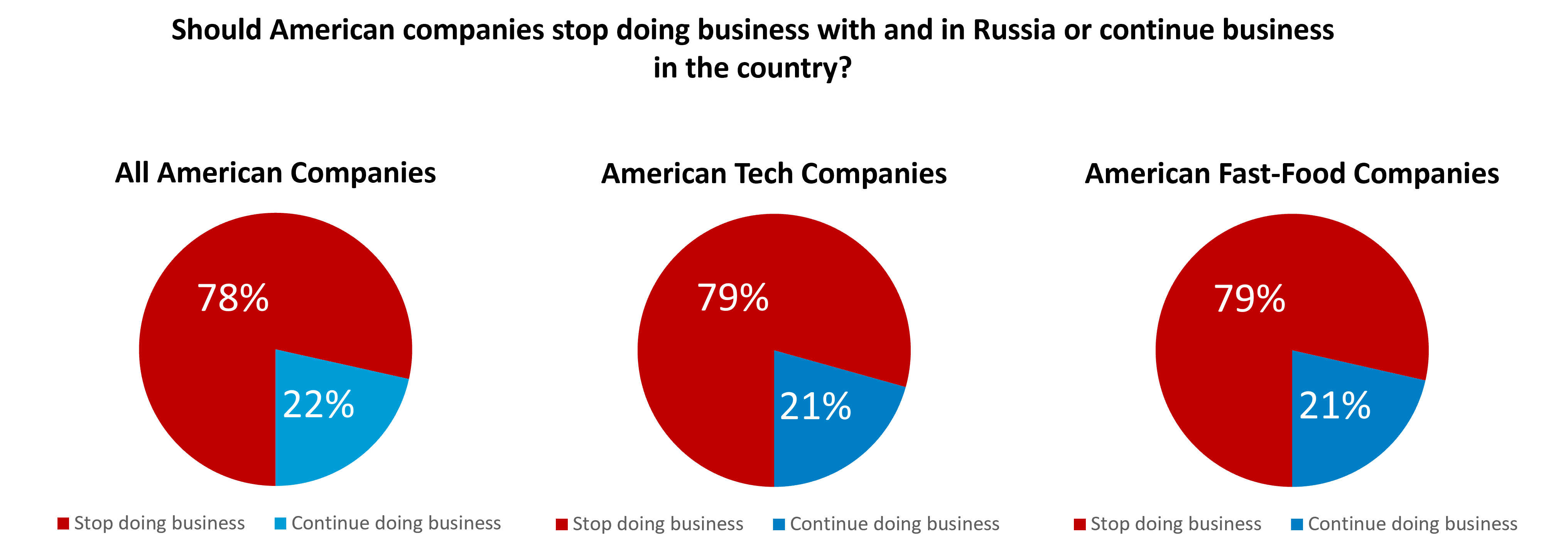
Of course, this decision is easy for companies who have little or no operations in Russia. It is more difficult for those companies that have made a major investment in the country. They may have thousands of employees, stores, and other investments. What will happen to those assets? Will they have an opportunity to re-open operations if peace is achieved? These are difficult questions given the larger ramifications those decisions have.
Given the illegal and immoral actions of Putin’s unrestricted shelling of innocent civilians, an overwhelming number of well-known brands have either pulled out of Russia or suspended operations there. Morality surely swayed many; Anonymous, the hacker group, also threatened cyber-attacks against companies that did not withdraw. In the U.S., the sentiment is so strongly in favor of Ukraine and against Russia that any company remaining in the region is likely to draw significant consumer and media disapproval. Watch Nestle closely: the brand took a middle ground, announcing it would continue to sell baby food and products while pulling out of more indulgent lines like KitKat, and are donating any profits to the Ukraine relief cause.
Tech in Hot Water
Tech companies are as likely to be banned by Russia as they are to ban operations in Russia. Tech companies have generally focused on US internal political battles and yet carried the accounts of the Ayatollah Khomeini of Iran on an unfiltered basis. RT, a U.S.-based news operation that really was a Russia propaganda front, operated online here for years without interruption. By continuing to operate, tech companies argue they are serving as a communications channel into Russia. At the same time, they could be vehicles for the spread of Russia propaganda. As of now:
- Facebook is banned in Russia while Goggle continues to operate there in limited fashion.
- Google News has been banned though it appears search is still operating. Google advertising has been shut down voluntarily.
- YouTube is operating but they have prevented the Russian military from posting videos of “liberation” on the site and so is under threat of being banned by Russia.
Business software companies like Salesforce, Slack, Dell, Microsoft and IBM stopped selling to new customers while supporting old ones for now. Many had policies of not doing business with the Russian military in any event. Perhaps the single most significant help from tech companies for Ukraine is the deployment of Starlink satellites by Elon Musk. These provide an uncuttable lifeline to the Ukrainian people and government to stay connected and communicate to the outside world.
Et Tu, Vodka?
Then there are the companies – especially vodka companies – that have for years traded on the idea they were Russian in origin, now communicating with consumers that they were really American or European after all. This is some careful marketing legerdemain.
Companies will not be able to right every wrong, and as a matter of policy we have encouraged companies to operate in areas like China as part of showing other cultures how democracy, and economic freedom work together. There is now far less belief that by working with rogue regimes, we can change them; 3 In 5 Americans in the latest HarrisX poll now reject that strategy and believe we are better off disengaging.
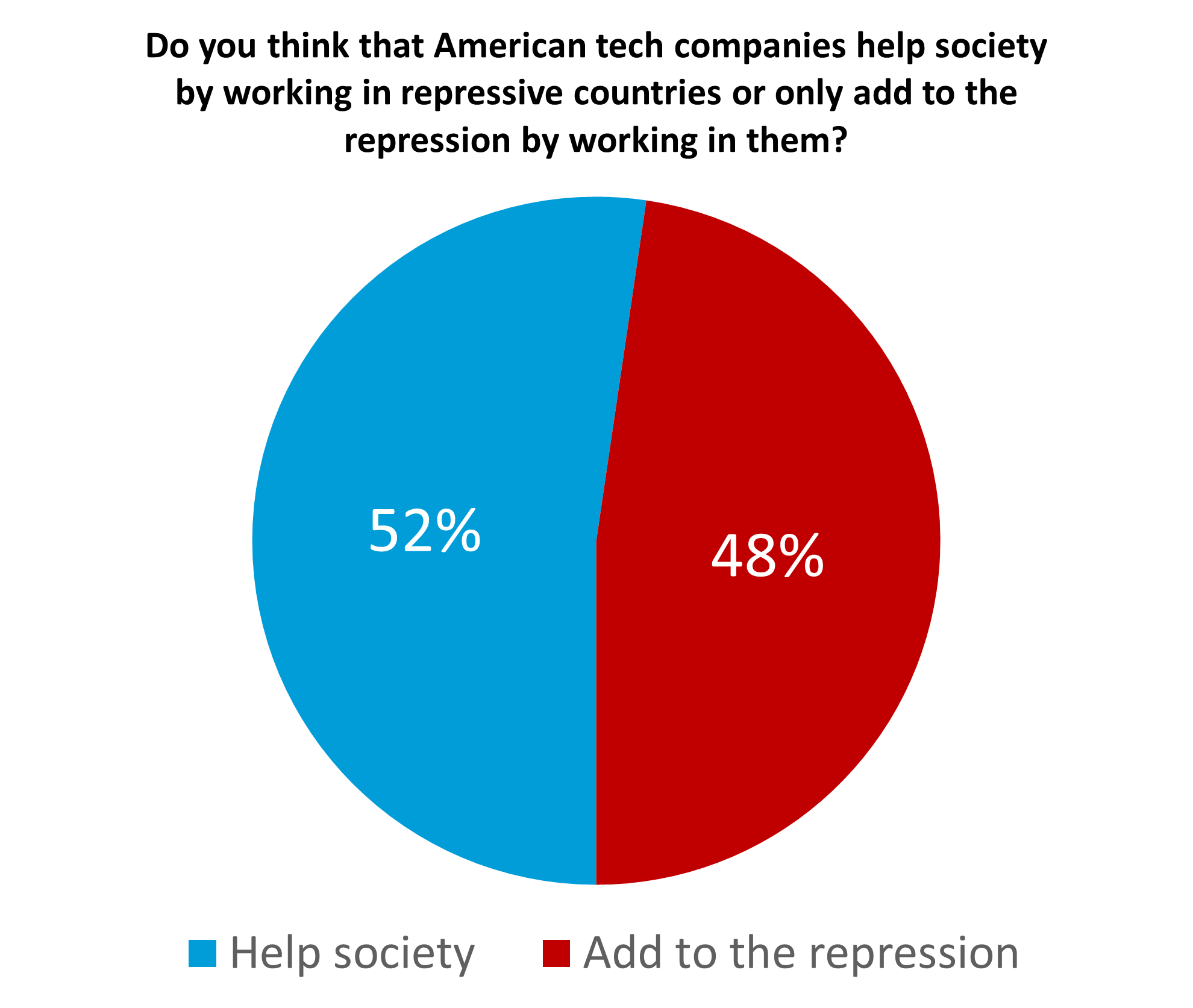
When President Bill Clinton addressed the conflict in Kosovo, a non-NATO country, in a speech that I helped work on, he argued stopping the atrocities against civilians there was an imperative because 1) it was morally right and 2) it was within our capacity to fix. The situation in Russia is similar as there is no real moral issue or debate – this is clearly naked and unjustified aggression on a scale we have not seen since World War II. American companies should feel confident that pulling out of their Russian operations will by and large not hurt their American operations. This is both the right thing to do and what is within our capacity as business leaders to do.
Have thoughts about the Russia-Ukraine war, brands’ responsibilities in it, or corporate purpose? Email me at mark.penn@stagwellglobal.com.
Related
Articles
In the News, Press Releases
Jun 13, 2025
Stagwell (STGW) Unveils Official News Network as an Extension of its Future of News Initiative, Allowing Clients Direct Access to Leading News Publishers

Artificial Intelligence, In the News, Marketing Frontiers, Press Releases, Stagwell Marketing Cloud, Tech
Jun 12, 2025
PRophet, a Stagwell (STGW) Company, Completes Integration of UNICEPTA, Launches Unified Brand and Enhanced Media Intelligence Offering

In the News, Marketing Frontiers, Press Releases, Stagwell Marketing Cloud, Tech
Jun 11, 2025
The Marketing Cloud Launches Cutting-Edge Platform to Simplify Marketing Workflows

Newsletter
Sign Up
Stagwell is the challenger network built to transform marketing, deliver excellence for the world’s most ambitious brands by connecting culture-moving creativity with leading-edge technology. That’s why Stagwell loves SXSW, which is all about the intersection of technology, innovation and culture – a great fit for a global company committed to transforming marketing, content, and experiences.
Here’s a roundup of Stagwell showed up at SXSW, what we learned, and what it means for marketers:
The 5 Things You Missed at SXSW
From NFTs and the evolving Web3 landscape to the transformative power of digital audio, Stagwell’s experts share the top five trends and brand takeaways from SXSW 2022.
Get Smart with Matt Maher
Stagwell contributor Matt Maher provided “Get Smart” videos throughout the week, making sure those watching from home didn’t miss a single thing, and that those on the ground could keep up with the hours of programming SXSW put forward this year.
Matt brought his experience as a marketing and technology expert to bear, sifting through the flash to determine which of the new trends and technology have staying power – and how marketers should be parcing them to make the most of every platform.
MATT’S KEY SXSW 2022 TAKEAWAYS:
- THIS WAS NFT’S YEAR AT SXSW but most brands haven’t fully connected the dots to turn NFTs into a sustainable, relevant, brand-building moment. Look to the Doodle x Shopify activation for the most successful implementation.
- CONTENT CREATION ISNT A NUMBERS GAME ANYMORE – from gaming to Instagram, it’s more important to have a dedicating following of 10k than an apathetic community of a million.
- THE METAVERSE CONVERSATION IS MORPHING from enthusiasm to skepticism as it runs against ongoing tech debates – data, privacy and the psychological impact on users over time. We havent’ written it off yet, but brands have some big decisions to make before jumping in.
Matt walks us thorugh all this in more in his Get Smart series from the festival, check them our below and on the Stagwell @ SXSW YouTube playlist.
Stagwell’s on the Ground Recap with Nick Fuller
Why brave the Austin heat (or cold, as it was this year) when you have digital transformation expert Nick Fuller, Managing Partner of Digital Transformation at Stagwell, on the ground to make sense of it all for you? He’s our sherpa for all things technology x marketing, and his takeaways from a weekend on the ground show a bias towards first-mover advantage when it comes to all things Web3. There is also a new interpretation of the age old question of authenticity – whether its in creator partnerships or buy-in on new tech platforms, there’s a huge upside for brands who are operating with a clear vision of their message and where they fit in the market.
Driving the Future of Marketing with Stagwell
Marketing moves fast – and we’re ahead of the curve. On Monday March 14, Stagwell held an invite-only event at Circuit of the Americas, the US’ first and only purpose-built F1 track, to give this industry’s saviest competitors a once-in-a-lifetime experience.
The day started with a panel featuring Bennett Richardson, President of Protocol, Gayle Troberman, CMO of iHeart Media and Sally Shin, Chief Strategy Officer at UnitedMasters, discussing the future of audio marketing. They touched on core themes unearthed by Stagwell’s March Marketing Frontier on the Future of Audio, including the power fo audio and a connective device and the untapped potential of audio as an avenue for first-party data collection.
The group then broke up to make some noise themselves, rotating through a half-day racing school taught by the legendary Skip Barber Racing School. In no time, our marketing pros became driving pros, learning the fundementals for open-wheel race car driving from Skip Barber instructors who among them boasted half a dozen top-place finishes in racing classes across the board. It was an unforgettable day, and a reminder of why pushing the limits and moving quick can transformt he way you see a problem – and see the world.
Originally released on
CONTACT
Lorem Ipsum
FEATURING
Related
Articles

Events, In the News, Investments & Financials, Press Releases
Jun 09, 2025
Stagwell (STGW) CEO and Chairman Mark Penn to Host Ask Me Anything (AMA) on Reddit to Discuss the Future of Marketing

Events, In the News, Press Releases, Talent & Awards
Jun 05, 2025
Code and Theory Named ANA B2B Agency of the Year After Transforming the World’s Leading Brands

Newsletter
Sign Up
For realtime insights, follow us on LinkedIn
A roundup of Stagwell’s work at Super Bowl 2022:
Stagwell’s agencies are transforming marketing – on one of the most captive fields for national marketing, the Super Bowl. Several of our agencies are showing up at the Big Game this year: Anomaly for Meta, Vroom and Expedia; 72andSunny for the NFL; Forsman & Bodenfors for Polestar; and more. Off the TV screen, our agencies are innovating with omnichannel efforts that tap into the fever and fandom of the big game to drive powerful consumer moments for their brand partners.
We believe that there’s a new definition of success for advertisers at the Super Bowl, and it’s driven by digital transformation and changing consumer expectations around brands and experiences. Stagwell is leading the charge in supporting brands as they navigate this new dynamic – explore Stagwell’s presence at The Game, both traditional and less so, below.
But before you dive in:
Captain Morgan x Anomaly
Captain Morgan’s high-tech punch bowl syncs with real-time game data to keep fans in the loop, even when they’re getting a refill.
Meet the Super Bowl snack table addition you never knew you needed: the Captain Morgan Super Bowl Punch Bowl. Anomaly worked with the Captain Morgan team to bring to life the bowl, featuring stadium-inspired lights and sound, Bluetooth speakers, subwoofers and LED graphic equalizers that sync with real-time game data to create an immersive brand experience.
Plus, don’t miss it’s apperance on Jimmy Fallon.
Cenex x Colle McVoy
Colle McVoy created a new campaign for Cenex that celebrates the quirky, charming and often humorous moments of connection that people experience at their local convenience stores. The campaign shows how its 1,500 locations in 19 states power communities while helping to connect people. It’s the next evolution of the brand’s successful Powered Locally platform and includes six :15 spots, two debuting in a few weeks during Super Bowl 56 in 20 Midwest regional markets.
Crosstown Rivals (premiering 2/13/22)
Local Entertainment (premiering 2/13/22)
CUE Health x Doner
Like COVID itself, at home testing company CUE is quick to adapt, putting together a spot in just eight days with Doner. Voiced by Gal Gadot, the ad positions the smart at home testing technology in conversation with a family’s other smart home devices – just another addition to the growing suite of at technologies that keep us safe, run more efficiently, and provide peace of mind. And while COVID is top of mind now, CUE promises that they’re just getting started.
How COVID Testing Brand CUE Put Together a Super Bowl Ad in 8 Days (AdAge)
Expedia x Anomaly
Ewan McGregor gives a convincing plug for the power of experiences over ‘stuff’
As the travel industry looks to continue to gain footing and recover from COVID-drivel losses, Expedia is leading the pack in its commitment to the Big Game with a spot created by Anomaly. With an emphasis on experiences over things, the spot aims to redefine the relationship between the platform and its customers, while challenging the expectations that travelers may have for Expedia and its sister brand, Vrbo.
‘Ewan McGregor and Expedia have Teamed Up to Give Away Free ‘Trips’ on Super Bowl Sunday’ (Forbes)
‘Why the 2022 Super Bowl Makes Sense for Brands’ (AdAge)
‘Can Super Bowl Ads Make Expedia Group the Nike of Travel?’ (AdWeek)
Groupon x Allison+Partners
Gronk is getting out of town… and opening his hope to one lucky winner for the experience of the lifetime.
Allison+Partners led PR for Groupon’s “Party Like a Player” Super Bowl sweepstakes campaign featuring Rob Gronkowski that underscored the brand’s positioning as the go-to experience marketplace. The team secured coverage in USA Today, TMZ Sports, ABC Audio, Travel + Leisure and many more resulting in 3.7B impressions (and counting) in its first week.
LikeMeat x 72andSunny
LikeMeat is celebrating the Big Game with a TikTok scavenger hunt, created by 72andSunny and Blue Hour Studios. To promote its plant-based Chick’n Wings product launch, LikeMeat has invited TikTok users to hunt for digital clues that crack a secret code. Those who unlock the code have a chance to win two free tickets to the Super Bowl as well as other LikeMeat-branded prizes. It’s yet another example of brands going digital-first for the big day, eschewing traditional spots for lower-budget, higher impact activations to connect with their audiences.
Why a plant-based food company started the first TikTok scavenger hunt featuring Gronk just in time for the Super Bowl (Digiday)
Got Milk? x GALE
The milk industry is making a statement at this year’s Super Bowl – that what you’re seeing on the field is not the whole picture. Their spot, airing on the NFL Network and created by GALE, is an inclusive look at the power of women in sport, even (and especially) where they aren’t expected. Featuring women from across the Women’s Football Alliance, the tagline “Football is Football” encourages a broader look at the game and the powerful changemakers behind it.
NFL x 72andSunny
After topping the USA Today Ad Meter last year, 72andSunny + NFL are returning to the screens this year just before halftime with another spot that aims to capture the magic, legacy and power of the game. Featuring cutting edge puppetry and CGI technology from experts at Swaybox, the ad features legendary NFL talent in unexpected places and spaces – bringing the game right into viewers homes. Get ready to bring down the house.
‘
”They Will Be Blown Away’: NFL’s Next Step in ‘Future-Proofing’ Audience Begins with a Super Bowl Ad’ (USA Today)
‘Behind the NFL’s Super Bowl Ad Plans, Which Include Puppetry and CGI’ (AdAge)
Polestar x Forsman & Bodenfors
In it’s first Super Bowl ad, Polestar, the high-end EV company with roots in Sweden, joined a spate of automakers – with a very different approach. The minimalist 30-second spot, executed by F&B, places a focus on what it doesn’t have – gimmicks, punchlines, scandals and distractions. It’s all about the future, driven by electric.
‘Swedish EV Startup Polestar Makes Super Bowl Debut with a “No Cliche” Approach’ (Ad Age)
Quest Oculus for Meta x Anomaly
In it’s first Super Bowl as the newly-rebranded Meta, Oculus Quest is doubling down on the metaverse, with a clear message to the audience – the metaverse is already here, and we’re waiting for you. The full spot, created by Anomaly and premiered on Good Morning America on Feb. 10, shows a metaverse in full swing – including a very-real post-game concert that will be headlined by the Foo Fighters. Its giving people a reason to visit the virtual reality world Meta is building – and pulling viewers into the future they are creating.
‘Inside Meta’s Super Bowl Commercial for the Metaverse’ (AdAge)
‘Meta’s Super Bowl Commerical Depicts Old Brand’s New Life in the Metaverse’ (AdAge)
Tillamook x 72andSunny
72andSunny created a shoppable, digital only music video, Chedderbration to mark National Cheddar Day coinciding with the Super Bowl. The multimedium campaign includes limited edition merch, unique cheddar-based recipes, and coupons accessible only through the Cheddarbration homepage.
Vroom x Anomaly
Vroom’s Super Bowl 2022 commercial sings the praises of a reliable broker – literally
Anomaly makes a return Super Bowl appearance with Vroom, the online car retailer who is literally singing the praises of having a reliable dealer on your side during the car selling process. The 30 second spot again features high-tempo choreography from celebrity choreograper Mandy Moore.
‘Vroom Releases Super Bowl 56 Ad ‘Flake: The Musical” (AdAge)
Related
Articles
In the News, Press Releases
Jun 13, 2025
Stagwell (STGW) Unveils Official News Network as an Extension of its Future of News Initiative, Allowing Clients Direct Access to Leading News Publishers

Artificial Intelligence, In the News, Marketing Frontiers, Press Releases, Stagwell Marketing Cloud, Tech
Jun 12, 2025
PRophet, a Stagwell (STGW) Company, Completes Integration of UNICEPTA, Launches Unified Brand and Enhanced Media Intelligence Offering

In the News, Marketing Frontiers, Press Releases, Stagwell Marketing Cloud, Tech
Jun 11, 2025
The Marketing Cloud Launches Cutting-Edge Platform to Simplify Marketing Workflows

Newsletter
Sign Up
By Mark Penn, Chairman and CEO, Stagwell
CONTACT
hello@stagwellglobal.com
FEATURING
Marketing Frontiers is a new series from Stagwell exploring the methods, mediums, and messes modern marketers will grapple with over the next decade as they chart transformation in the discipline. This February, Stagwell is exploring NFTs.
NFTS are an opportunity brands shouldn’t pass on.
Two strategies are driving value: incentivizing real-world action with NFTs, and using them to build loyal long-term consumer segments.
In the old days, marketing companies incentivized consumers with free toasters. Today, they give you an NFT, a digital good that may be even more useful. It’s easy to confuse the NFT craze with other emerging new technologies but they stand apart as offering several unique areas of potential value. First, they provide individually usable coupons or discounts that can be tracked; Second, they offer permanent digital copies of paper goods; and third, they offer collectible opportunities that could soar in value,
Brands want to experiment with NFTs but are struggling to determine whether it’s a fad or an effective long-term brand strategy. They must balance wanting to be first movers on exciting new tech that is racking up serious investment while pursuing virtual items as ways to connect digital and in-person experiences. But barriers make this investment difficult, including the expensiveness inherent in producing some types of NFTs, the wild fluctuation in selling prices, and the knowledge gap among consumers who are confused or otherwise skeptical about the technology.
While it’ll be a while before we can gauge the long-term impact of the NFT activations in the market now, it’s clear from early experiments that two styles of NFT activations are proving successful: those that connect digital incentives to real-world action, and those that help build long-term, loyal consumer segments for brands – either within or beyond their usual consumer base. Sports marketers and luxury fashion brands are leading the charge on effective NFT adoption.
NFTs are too important of an opportunity for today’s brands to pass on.
Incentivizing and Rewarding Real-World Action: Sports Brands
This Super Bowl, the NFL and Ticketmaster are partnering to provide in-person spectators free NFTS that commemorate their tickets and serve as digital keepsakes, giving an added boon to die-hard fans for their commitment to filling stadiums and solving for consumers who want a souvenir from the experience but are prone to losing ticket stubs. In addition to the free, wide-cast NFTs, a set of limited-edition tokens will be released to commemorate past Super Bowls hosted in the city of Los Angeles.
Giving consumers something meaningful for attending in-person events that taps into fandoms, hometown loyalty, and the desire to remember exciting experiences is one avenue of common-sense NFT adoption. These are not the flashy, expensive digital art being auctioned the NFT world is known for, but affordable, scaled and tied directly to an activity that fans have already shown engagement with: collecting stubs. These efforts teach a simple lesson about how to forge new paths with emerging technology: don’t reinvent the wheel; look for ways NFTs enhance or supplement existing real-world action.
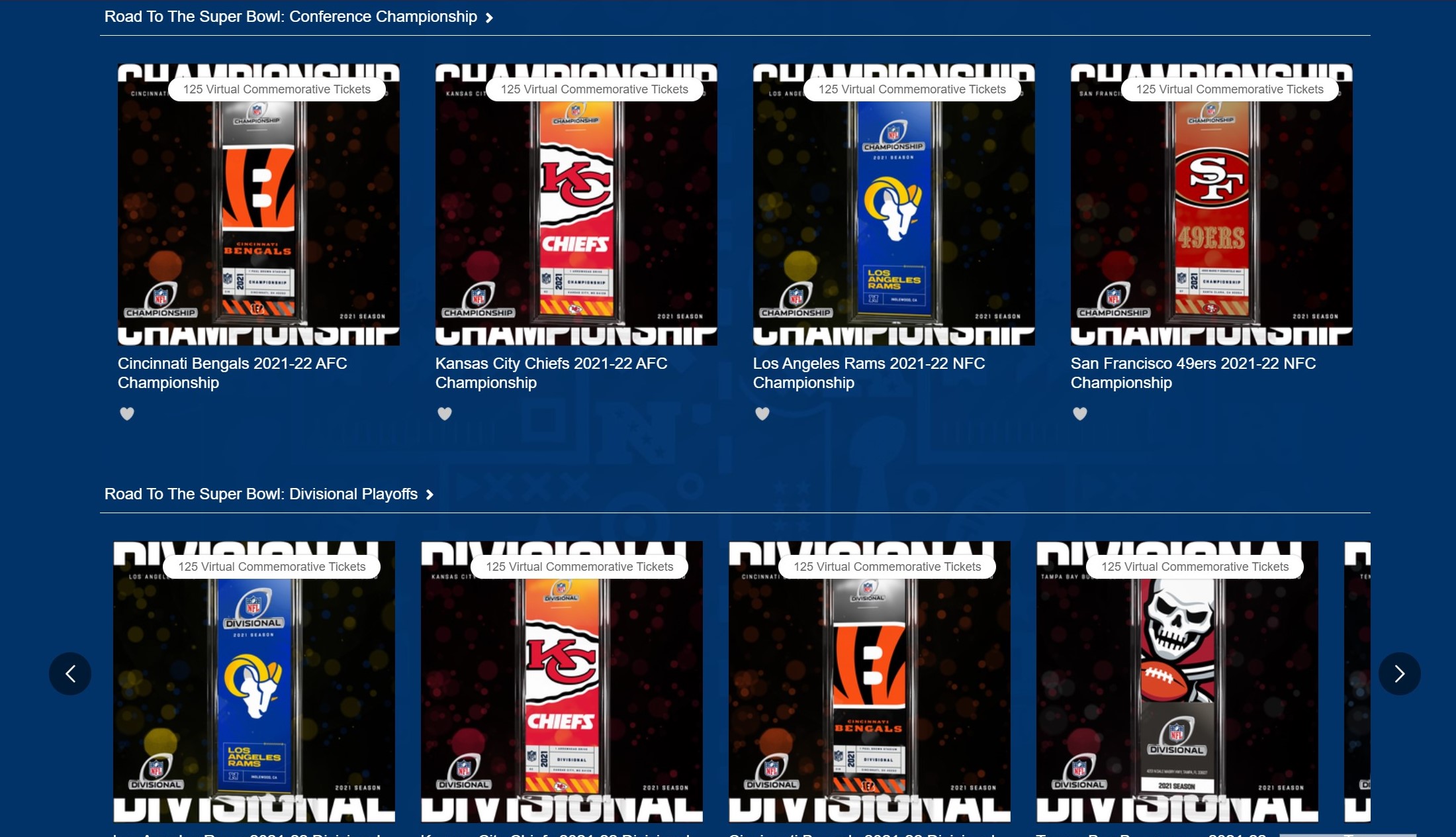
A screenshot of the N.F.L.’s Virtual Marketplace for NFTs and other collectibles.
Building Loyal Long-Term Consumer Segments: Luxury Fashion and Apparel Brands
NFL/Ticketmaster’s effort doubles as a window into how NFTs are tapping into supercharged fan bases to build long-term, loyal consumer segments. Beyond sports, luxury fashion brands use NFTs to engage up-and-coming, nascent consumer segments and prime them for long-term engagement. Louis Vuitton rolled out an adventure game commemorating its founder’s 200th anniversary birthday, featuring a selection of hidden NFTs and a set of ultimate prizes tied to exclusive, real-world offerings. And this year, NYFW goes virtual – presented by Decentraland, the popular Metaverse destination. Decentraland will host a digital component to NYFW that includes runway shows and immersive experiences, branded NFT collections, and other collectibles and digital tokens. These efforts engage a younger set of consumers who may not yet have the disposable income for luxury material purchases in real-life but are attracted to the exclusiveness of the brand and excited for the digital follow-through.
We think NFT’s are too important an opportunity for today’s brands to take a pass on. We believe every brand needs to play in the space in coming years and integrate NFTs into their campaigns. Fans want digital assets of their favorite players; traceable coupons make great targeted assets to enhance customer experience; and everyone loves to collect something that could be valuable.
Sign up to receive more insights from Stagwell and follow us on LinkedIn to stay abreast of news, work, and perspectives from our global network.
Related
Articles
In the News, Press Releases
Jun 13, 2025
Stagwell (STGW) Unveils Official News Network as an Extension of its Future of News Initiative, Allowing Clients Direct Access to Leading News Publishers

Artificial Intelligence, In the News, Marketing Frontiers, Press Releases, Stagwell Marketing Cloud, Tech
Jun 12, 2025
PRophet, a Stagwell (STGW) Company, Completes Integration of UNICEPTA, Launches Unified Brand and Enhanced Media Intelligence Offering

In the News, Marketing Frontiers, Press Releases, Stagwell Marketing Cloud, Tech
Jun 11, 2025
The Marketing Cloud Launches Cutting-Edge Platform to Simplify Marketing Workflows









